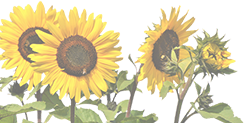
Understanding Fertilizers
By Chris Edmunds

Maintaining a healthy garden starts with giving your plants the nutrients they need, especially high-feeding annuals. You may be intimidated by the world of fertilizers, wondering what the numbers mean or what they actually contain! Luckily, fertilizers are easily categorized for understanding. To help you, we’ve broken it down:
Types of Fertilizers
 There are two types of fertilizers; organic and inorganic. Although organic fertilizers may be more environmentally-friendly, they are usually made up of unpleasant materials, like manure, worm castings, and slurry. Always be cautious of organic fertilizers that fail to tell you what they contain. Organic fertilizers will feed the soil as well as the plant, but take longer to work.
There are two types of fertilizers; organic and inorganic. Although organic fertilizers may be more environmentally-friendly, they are usually made up of unpleasant materials, like manure, worm castings, and slurry. Always be cautious of organic fertilizers that fail to tell you what they contain. Organic fertilizers will feed the soil as well as the plant, but take longer to work.
Inorganic fertilizers much more common in stores and are similar to vitamins for plants. You can enjoy rapid plant growth with their quick and easy-to-digest nutrients. These are more potent fertilizers that have higher nitrogen, phosphorus, and potassium contents. Most inorganic fertilizers are harmless to pets and are non-toxic.
Decoding Fertilizers
 All fertilizers are made up of three elements: nitrogen, phosphorus, and potassium. You can determine how much of each element is contained in the fertilizer by looking at the numbers on the packaging. Each number represent percentages - the higher the number, the higher the quantity! The numbers will never add up to 100, and the rest of the ingredients are usually a benign filler.
All fertilizers are made up of three elements: nitrogen, phosphorus, and potassium. You can determine how much of each element is contained in the fertilizer by looking at the numbers on the packaging. Each number represent percentages - the higher the number, the higher the quantity! The numbers will never add up to 100, and the rest of the ingredients are usually a benign filler.
The first number is Nitrogen, which encourages healthy foliage and leaf growth. You can tell if your plant is lacking nitrogen by looking for any pale or sickly looking leaves. If your plant has too much nitrogen, they will have beautiful foliage but lack flowers. The second number is for Phosphorus, which promotes healthy roots. The third and last number represents the amount of Potassium. Potassium works like a multivitamin, giving your plants all the micro-nutrients they need.
Choosing the Right Fertilizers
Having the right amount of phosphorus in your fertilizer is important for a healthy garden and environment. Recent studies by horticultural universities have discovered that many vegetable fertilizer brands have been giving plants too much phosphorus. Not only is an excess amount of phosphorus harmful to the environment, but it can leak into groundwater and eventually build up on the soil to the point of toxicity.
 You can be sure that our KVG “The Good Stuff” fertilizers are perfectly formulated with the right amount of phosphorous. You’ll keep your beautiful flowers and heavy producing vegetable gardens well fed! Our top-performing fertilizers come in Control Release and Water-Soluble formulas. Pick up a bag at our plant nursery in Andover!
You can be sure that our KVG “The Good Stuff” fertilizers are perfectly formulated with the right amount of phosphorous. You’ll keep your beautiful flowers and heavy producing vegetable gardens well fed! Our top-performing fertilizers come in Control Release and Water-Soluble formulas. Pick up a bag at our plant nursery in Andover!
Our Premium Controlled Release Plant Food (15-7-15) is made up of coated, slow-release pellets that allow plants to absorb nutrients over a number of months. You can be sure that this low-maintenance fertilizer will keep your garden fed over the summer. For best results, we recommend working the fertilizer into the top 1 to 3 inches of soil for new plantings. For established outdoor bedding plants or container gardens, you can spread the product along the top of the soil. Reapply after 4 to 6 months.
Our Premium Water-Soluble Plant Food (24-7-15) acts as quick-release fertilizer when mixed with water. If your garden isn’t blooming or looks dull, this a quick way to replenish their nutrients. During the outdoor growing season, we recommend applying this formula to your container garden every 7-14 days. Since plants can be fed through their leaves, you won’t need to worry about wetting their foliage. You can also apply this formula to indoor plants! Use only once a month in the summer and be sure to thoroughly wet them.
To help keep your new growing annuals fed with nutrients, we recommend using our control release fertilizer upon planting and our water-soluble fertilizer every two weeks until the temperature reaches a consistent 92℉.
Giving your garden enough nutrients is an important factor in maintaining a beautiful garden. By choosing fertilizers with low amounts of phosphorous, you’ll keep your plant’s roots strong and your soil healthy. Visit any of our garden centers for to browse our high-performing KVG fertilizers.

